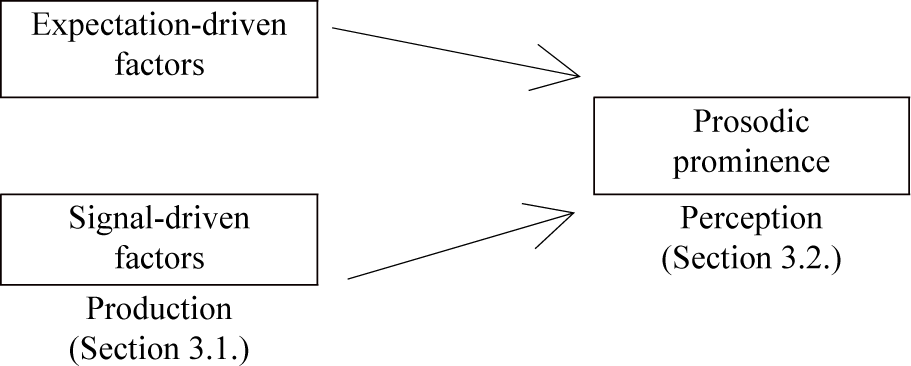1. Introduction
In English, the vowels which convey prosodic prominence are higher in pitch, longer in duration, greater in intensity, steeper in spectral slope, and hyperarticulated compared with the ones which do not (Beckman, 1986; Breen et al., 2010; Cole et al., 2007; Kochanski et al., 2005; Sluijter & van Heuven, 1996; Turk & White, 1999, among others). There is consensus that duration and intensity play important roles in perceptions of prosodic prominence, while existing research varies on the role of F0. Kochanski et al. (2005) examined a spontaneous speech in the corpus of British and Irish English. They found that loudness and phone duration strongly correlated with prosodic prominence, while other acoustic measures, including F0 measures and spectral slope, did not. Cole et al. (2019) investigated a spontaneous speech in the Buckeye corpus of American English and found that phone rate, intensity, and max F0 strongly correlated with prosodic prominence. Among the acoustic correlates, phone rate was the strongest correlate of prosodic prominence.
Prosodic prominence is not only associated with acoustic cues, but also related to other linguistic and paralinguistic factors. Prosodic prominence may encode the information status of a word, rhythm, speech style, speech mode, and so on (Calhoun, 2010; Chodroff & Cole, 2018; Hirschberg, 1993, Im et al., 2023; Pierrehumbert & Hirschberg, 1990; Vogel et al., 1995, among others). Linguistic factors’ effects on perceptions of prosodic prominence have been investigated (Aylett & Turk, 2004; Baumann & Winter, 2018; Bishop et al., 2020; Breen et al., 2010; Cole et al., 2010, 2019; Im et al., 2023; Turnbull et al., 2017; Watson et al., 2008, among others). Cole et al. (2010) identified two types of linguistic factors based on the cognitive processes of perception: (1) the expectation-driven factors that listeners have prior experiences with the language use or discourse context, and (2) the signal-driven factors that listeners have real time information while listening to the speech. They examined the effects of expectation-driven factors (e.g., lexical repetition, lexical frequency) and signal-driven factors (e.g., acoustic cues) on perceptions of prosodic prominence in the Buckeye corpus of American English. Results showed that (a) prosodic prominence was partly influenced by both expectation-driven factors and signal-driven factors, and (b) expectation-driven factors contributed more to perceptions of prosodic prominence than did signal-driven factors. In a similar vein, Im et al. (2023) examined the effects of information status and pitch accents, as expectation-driven factors, and acoustic cues, as signal-driven factors, on perceptions of prosodic prominence in a public speech of American English. They found that expectation-driven factors (i.e., information status, pitch accents) mediated the effects of signal-driven factors (i.e., acoustic cues) in perceptions of prosodic prominence.
One expectation-driven factor that may play an important role is the identity of the vowel. Previous experimental evidence shows that vowels have intrinsic differences (Fahey & Diehl, 1996; Heffner, 1937; House, 1961; House & Fairbanks, 1953; Kingston, 1992; Lehiste & Peterson, 1959, 1961; Peterson & Barney, 1952; Peterson & Lehiste, 1960; Whalen & Levitt, 1995; Whalen et al., 1999; Young et al., 2001, among others). For monophthongs, high vowels are higher in F0, shorter in duration, and lower in amplitude than low vowels. Lehiste (1970) examined the loudness of vowels in English. Although amplitude was actually higher for low vowels than for high vowels, listeners considered the vowels with more articulatory effort (i.e., high vowels) louder than the vowels with less articulatory effort (i.e., low vowels). This indicates that listeners’ perceptions reflect not merely acoustic cues but multiple factors, including vowel identity and its associated articulatory effort in the speaker’s production. For diphthongs, the initial vowel tends to determine the F0 and intensity of the entire vowel (Lehiste, 1970). Considering that vowels are the anchors of prosodic prominence, it is possible that vowels’ intrinsic differences influence perceptions of prosodic prominence. Despite vowels’ potential effect on prosodic prominence, this issue has not been fully addressed in previous research on perceptions of prosodic prominence in relation to expectation-driven and signal-driven factors (e.g., Cole et al., 2010; Im et al., 2023).
The present study investigates how prosodic prominence is influenced by vowel identity (as an expectation-driven factor) and associated acoustic cues (as signal-driven factors) with linguistically untrained listeners using a public speech in American English. The research questions of the present study are summarized as follows:
(1) How are vowels phonetically realized in a public speech of American English?
(2) How do the phonological and phonetic information of vowels in the speech influence perceptions of prosodic prominence by linguistically untrained listeners?
Given the previous experimental evidence that (a) high and low vowels are associated with higher F0, duration, and intensity than are mid vowels, and (b) perception of prosodic prominence is likely associated with F0, duration, phone rate, and intensity, we expect that high and low vowels may affect perceptions of prosodic prominence more than will mid vowels. For this, we will first examine how the vowels differ from one another in the speech material’s phonetic realization (Section 3.1.). Next, we will look at how vowel identity and associated acoustic cues (i.e., max F0, F0 range, phone rate, and mean intensity) influence perceptions of prosodic prominence (Section 3.2.). The schematic representation of the present study, adopted from Cole et al. (2010), is shown in Figure 1.
Although more linguistic factors are known to be involved with perceptions of prosodic prominence, as shown in the previous research above (e.g., Cole et al., 2010; Im et al., 2023), this study focuses on the effects of vowel entity and associated acoustic cues on prosodic prominence, which previous research has not fully examined. Based on the results, the present study aims to expand our understanding of perception of prosodic prominence as a function of expectation-driven and signal-driven factors.
2. Method
Thirty-five native speakers of American English (12M, 23F, Mage=24.3) participated in a perception experiment. Most of them were undergraduate or graduate students at a Midwest University in the U.S. The participants were asked to listen to a speech on an online platform called Language Markup and Experimental Design Software (Mahrt, 2013) and select the words they perceived as prominent on a transcript of the speech (Rapid Prosody Transcription; Cole & Shattuck-Hufnagel, 2016). A prominent word was defined as one that sounds higher, longer, and louder, compared to the surrounding words in an utterance. The speech material was obtained from TED Talks and was entitled “Try something new for thirty days” as shown in (3) (www.ted.com/talks/matt_cutts_try_something_new_for_30_days). A male speaker of American English delivered the speech in a clear and lively style. The entire speech was broken into four pieces presented in chronological order during the experiment. The experiment took less than 30 minutes. After the experiment, the participants received monetary compensation.
(3) A few years ago, I felt like I was stuck in a rut, so I decided to follow in the footsteps of the great American philosopher, Morgan Spurlock, and try something new for 30 days. The idea is actually pretty simple. Think about something you’ve always wanted to add to your life and try it for the next 30 days. (…)
The vowels of each word in the entire speech (n=361) were identified based on the CMU Pronouncing Dictionary (Weide, 2005). For most monosyllabic and polysyllabic words (n=293), the vowel with the primary stress was considered as the landing location of pitch accent and was analyzed in the study. Fourteen vowels were observed: /i/ (n=10), /ɪ/ (n=29), /eɪ/ (n=15), /ɛ/ (n=24), /æ/ (n=31), /ɝ/ (n=17), /ʌ/ (n=27), /aɪ/ (n=53), /aʊ/ (n=11), /u/ (n=25), /ʊ/ (n=7), /oʊ/ (n=11), /ɔ/ (n=11), and /ɑ/ (n=22). For some monosyllabic words (n=68), the vowel was considered to have no word-level stress, following the CMU Pronouncing Dictionary. These words were mostly function words (e.g., “a”, “the”, “to”, “is”). Five vowels, /i/, /ɪ/, /ɝ/, /ʌ/, and /ɔ/ were found and were categorized as unstressed vowel (UV) in the analysis (n=68). To summarize, the present study analyzes fifteen vowel categories in total, including those with and without primary stress (i.e., UV, /i/, /ɪ/, /eɪ/, /ɛ/, /æ/, /ɝ/, /ʌ/, /aɪ/, /aʊ/, /u/, /ʊ/, /oʊ/, /ɔ/, and /ɑ/).
The four acoustic measures of words, max F0 (in semitones), F0 range (in semitones), phone rate, and mean intensity (in dB), were considered based on previous research on perceptions of prosodic prominence in American English (Cole et al., 2019). A word’s phone rate is a measure of duration that takes into account the speech rate of the utterance. It was measured with a Praat script from Cole et al. (2019). The three acoustic measures, max F0, F0 range, and mean intensity, were obtained from ProsodyPro (Xu, 2013). The F0 contour of a monophthong and a diphthong in the speech material can be found in the online Supplementary Material of this study. All the acoustic measures went through two steps of normalization following the previous research (Cole et al., 2019; Im et al., 2023): (a) the measures were normalized for the local context to capture how a word is higher in pitch, longer in duration (i.e., slower in speech rate) or louder in intensity, relative to surrounding words in an utterance. Each measure of a word was adjusted by the mean and standard deviation of the surrounding words using the five word-window centered on the target word. Next, (b) the measures were normalized for differences in units (e.g., semitones, dB). Each measure of a word was adjusted by the mean and standard deviation of the measure of the entire words. Increases in max F0, F0 range, and mean intensity are expected to increase the probability of perceived prominence. Increased phone rate (i.e., decreased duration), however, would decrease the likelihood of perceived prominence. To ensure that all the acoustic measures have similar relationships with perceived prominence (i.e., increases in the acoustic measures would increase the probability of perceived prominence), the analysis uses inverse phone rate.
We first examined the phonetic realization of each vowel in the speech. For this, we ran a multivariate multiple regression in R (R Core Team, 2022). The independent variables were fifteen vowels (UV, /i/, /ɪ/, /eɪ/, /ɛ/, /æ/, /ɝ/, /ʌ/, /aɪ/, /aʊ/, /u/, /ʊ/, /oʊ/, /ɔ/, and /ɑ/). The dependent variables were four acoustic measures (max F0, F0 range, inverse phone rate, and mean intensity).
Next, we looked at the effects of vowels’ phonological and phonetic information on linguistically untrained listeners’ perceptions of words’ prosodic prominence. For this, we ran a generalized mixed-effects model using the lme4 package (Bates et al., 2015) in R (R Core Team, 2022). The fixed factors were (1) vowel (UV, /i/, /ɪ/, /eɪ/, /ɛ/, /æ/, /ɝ/, /ʌ/, /aɪ/, /aʊ/, /u/, /ʊ/, /oʊ/, /ɔ/, and /ɑ/), (2) z-normalized max F0, (3) z-normalized F0 range, (4) z-normalized inverse phone rate, (5) z-normalized mean intensity, and (6) interactions between vowel, z-normalized max F0, z-normalized F0 range, z-normalized inverse phone rate, and z-normalized mean intensity. The dependent variable was listeners’ binary responses for prosodic prominence (0 as non-prominent, 1 as prominent). The random effect was the intercept of listeners. We also ran a post-hoc pairwise comparison with Tukey method based on the generalized mixed-effects model using the lsmens package (Lenth, 2016).
3. Results and Discussion
To address the first research question, we examined how the speech phonetically realized intrinsic vowel differences. Table 1 summarizes the multivariate multiple regression. Each cell indicates the estimated effect of a vowel (in row) in reference to UV (set as the intercept in the model) on the phonetic measure of a word (in column). In the multivariate multiple regression, the UV was set as the intercept so that the estimates of the vowels with the primary stress are comparable with each other.
We make a couple of observations. First, among all the vowels, only the diphthongs /aʊ/ and /aɪ/ showed statistical significance for all four phonetic measures, indicating that these vowels, compared to UV, significantly increase in max F0, F0 range, inverse phone rate, and mean intensity. Second, the vowels varied in relationship with phonetic measures. The mid vowels /ɛ/, /ʌ/, and /ɔ/ had significant relationships with all the phonetic measures except F0 range. In other words, these vowels, compared with UV, significantly increased in max F0, inverse phone rate, and mean intensity, while they did not extend F0 range. The low vowels /ɑ/ and /æ/ showed significant relationships with inverse phone rate and mean intensity but not with max F0 and F0 range, indicating that these vowels’ inherent characteristics, compared with UV, manifest in the non-F0 measures only. The high vowels /i/ and /u/ had significant relationships with max F0 and inverse phone rate but not with mean intensity, suggesting that high vowels are encoded by the increased max F0 and inverse phone rate. These results in the present study are broadly in line with those in previous studies (e.g., Fahey & Diehl, 1996; House & Fairbanks, 1953; Kingston, 1992; Lehiste & Peterson, 1959, 1961; Whalen & Levitt, 1995; Whalen et al., 1999; Young et al., 2001) in that high and low vowels are associated with F0 and intensity, respectively.
In order to examine which vowel is associated with more extreme phonetic value, we visualize the estimates of vowels for each phonetic measure based on the model output shown in Table 1. Figures 2–5 display the relationships between vowels and phonetic measures. Figure 2 shows the relationship between vowel (x-axis) and max F0 (y-axis). We observe that compared to UV, the vowels /i/, /ɛ/, /ʌ/, /aɪ/, /aʊ/, /u/, and /ɔ/ showed substantially higher max F0. These vowels can be rearranged from highest to lowest estimates as follows: /i/>/ɔ/>/aʊ/>/aɪ/>/ɛ/>/u/>/ʌ/. The other vowels, /ɪ/, /eɪ/, /æ/, /ɝ/, /ʊ/, /oʊ/, and /ɑ/ did not significantly differ from UV in max F0.
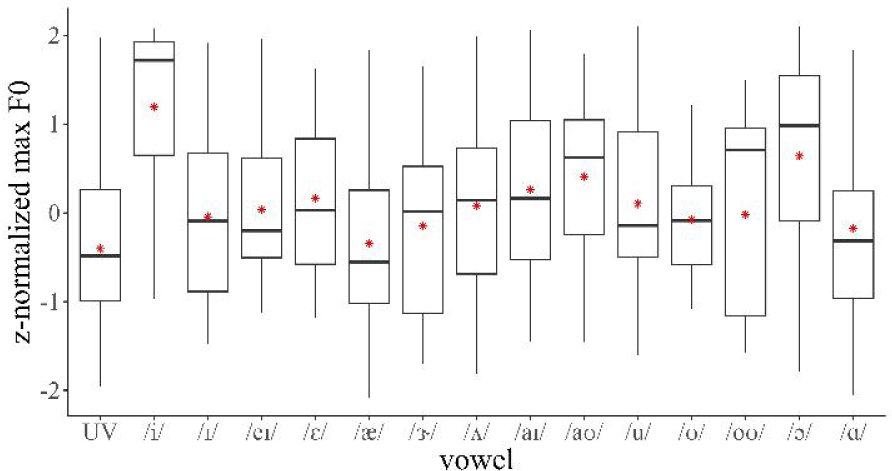
Figure 3 visualizes the relationship between vowel and F0 range. The vowel /i/ and the diphthongs /eɪ/, /aɪ/, and /aʊ/ had substantially expanded F0 ranges, compared with UV. These vowels can be rearranged in decreasing order of estimates: /i/ > /aʊ/ > /eɪ/ > /aɪ/. Compared with Figure 2, more vowels, /ɪ/, /ɛ/, /æ/, /ɝ/, /ʌ/, /u/, /ʊ/, /oʊ/, /ɔ/, and /ɑ/ in Figure 3 did not significantly differ from UV. From Figures 2 and 3, we confirmed that the high vowels show substantially higher F0 measures than the low vowels in the speech.
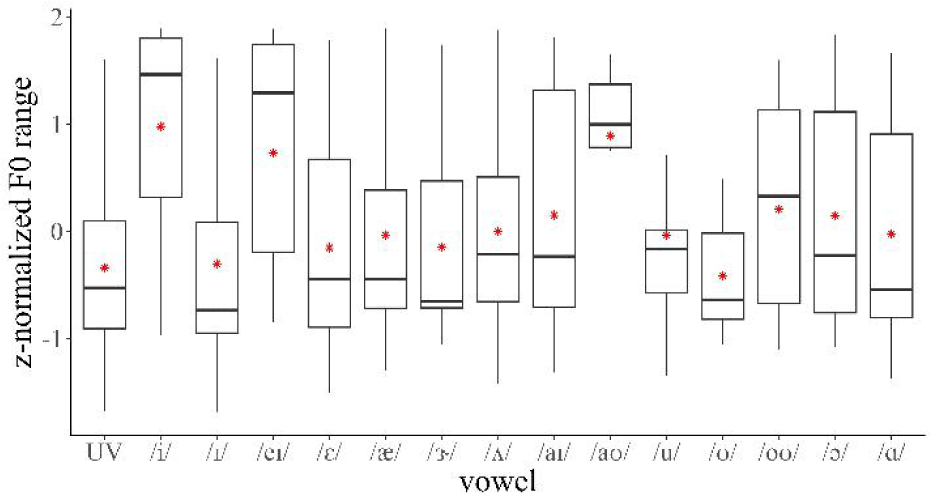
Figure 4 shows the relationship between vowel and inverse phone rate. All the vowels except /ʊ/ had significantly faster inverse phone rates (i.e., longer duration) than UV. Diphthongs tended to show higher estimates than monophthongs. This might not be surprising given that diphthongs, which combine two vowels, are inherently longer than monophthongs. What is surprising is the higher estimate of the high vowel /i/ than the low vowel /ɑ/. Previous research (Heffner, 1937; House, 1961; House & Fairbanks, 1953; Peterson & Lehiste, 1960) argues that duration should be longer for low than for high vowels due to the articulatory process (i.e., more time needed for larger jaw opening for low vowels than for high ones), which turned out not to be the case in the present study, perhaps due to differences in phonetic measurement (i.e., vowel duration in the previous research vs. word phone rate in the present study). The vowels can be ranked in decreasing order of estimates as follows: /eɪ/>/aɪ/>/i/>/aʊ/>/ɑ/>/ɝ/>/oʊ/>/ɔ/>/ʌ/>/ɪ/>/ɛ/>/u/>/æ/. Only the vowel /ʊ/ was found not to differ significantly from UV in inverse phone rate. In the speech material, /ʊ/ was mostly observed in function words (e.g., “your,” “would”) and could have been reduced. Perhaps for this reason, /ʊ/ might not have significantly differed from UV in F0 measures and inverse phone rate in this speech.
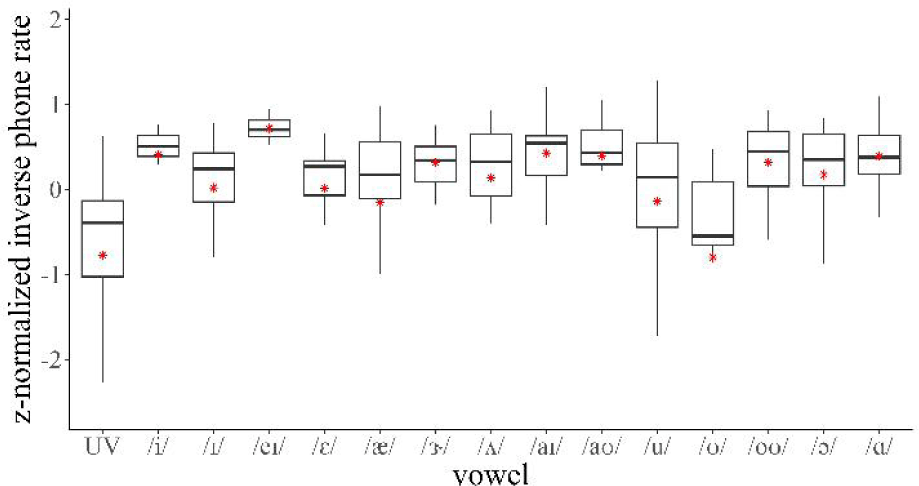
Figure 5 displays the relationship between vowel and mean intensity. Most vowels, /eɪ/, /ɛ/, /æ/, /ɝ/, /ʌ/, /aɪ/, /aʊ/, /ʊ/, /oʊ/, /ɔ/, and /ɑ/, showed substantially higher mean intensity than the UV. These vowels can be rearranged from highest to lowest estimates in the following order: /ɑ/>/ɝ/>/ɔ/>/aɪ/>/aʊ/>/oʊ/>/ʌ/>/ɛ/>/ʊ/>/eɪ/>/æ/. The three high vowels, /i/, /ɪ/, and /u/, did not significantly differ from UV in mean intensity. These results are consistent with the previous research (Lehiste & Peterson, 1959; Young et al., 2001) that low vowels have higher intensity than do high vowels.
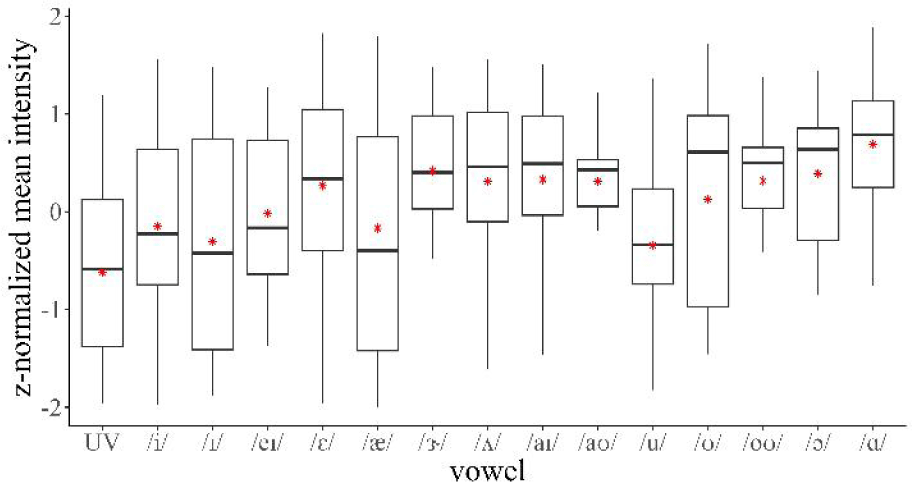
In sum, vowels vary in which phonetic cue they are strongly associated with. Compared to UV, the diphthongs are the only vowels that substantially increased in all phonetic measures, max F0, F0 range, inverse phone rate, and mean intensity. The other vowels substantially increased in some, but not all, phonetic measures. The mid vowels /ɛ/, /ʌ/, and /ɔ/ increased in all phonetic measures except F0 range. The low vowels /æ/ and /a/ were associated with higher inverse phone rate and mean intensity compared with the other vowels. The high vowels /i/ and /u/ were related to higher max F0 and inverse phone rate compared with the other vowels. These results from the current study, in alignment with those from previous research, suggest that vowels with more articulatory effort (i.e., high or low vowels) are associated with more extreme phonetic values (i.e., higher max F0, F0 range, inverse phone rate, and mean intensity) than ones with less articulatory effort (i.e., mid vowels).
To address the second research question, we examined how the phonological and phonetic information of vowels discussed in Section 3.1. influences linguistically untrained listeners’ perceptions of prosodic prominence. Table 2 summarizes the main effects from the generalized mixed-effects model. The summary of the model’s interaction effects can be found in the online Supplementary Material of this study. Each variable (in row) shows its estimated effect on the probability of a word being perceived as prominent. The vowel estimates were calculated in reference to the UV (set as the intercept in the model).
We observe that all the acoustic cues and all the vowels except /ʊ/ significantly affect the likelihood of perceived prominence. This suggests that not only the phonetic but also the phonological information of vowels influence perceptions of words’ prosodic prominence. In other words, listeners were likely to rate a word’s prosodic prominence, taking vowel identity into account independent of its associated acoustic cues in the speech. Only /ʊ/ did not significantly contribute to perceptions of prosodic prominence.
Figure 6 visualizes the effects of vowels (x-axis) on the likelihood of perceived prominence (y-axis) based on Table 2. The vowels can be rearranged from highest to lowest estimates as follows: /ɛ/>/ʌ/>/ɑ/>/ɔ/>/aʊ/>/i/>/æ/>/oʊ/>/eɪ/>/ɪ/>/ɝ/>/u/>/aɪ/>/ʊ/> /ə/. The mid vowels /ɛ/ and /ʌ/ tended to have higher effects on probability of perceived prominence than did high and low vowels. This is surprising given that mid vowels are not considered to have effortful articulatory processes and extreme acoustic values (c.f. high and low vowels). Taken together, these results suggest that the acoustic information of vowels in the speech might not directly influence perceptions of prosodic prominence and may be mediated by other expectation-driven factors, including vowels’ phonological information. If acoustic cues related directly to perceived prominence, we should have observed that high and low vowels with more extreme acoustic realizations were perceived as more prominent than mid vowels, which turned out not to be the case in the present study.
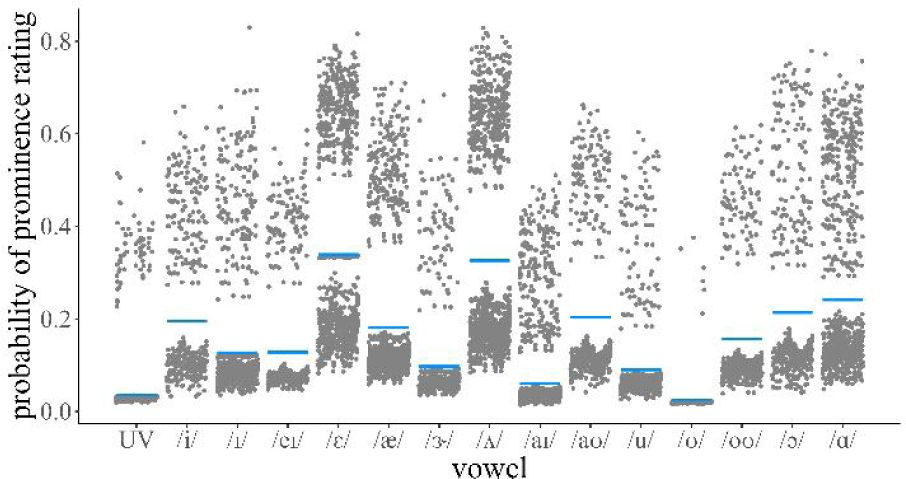
A post-hoc pairwise comparison shows that vowels can be categorized into four classes, as shown in Table 3. Vowels’ estimated effects on perceived prominence decrease from Class 1 to Class 4 (i.e., high effects for Class 1 and low effects for Class 4). Class 1 includes the mid vowels /ɛ/ and /ʌ/. From the post-hoc pairwise comparison, there was no significant difference between /ɛ/ and /ʌ/ (β=–.06, z=–.55, n.s.) while /ɛ/ significantly differed from /ɑ/ (β=–.48, z=–3.85, p<.05*).
| Class | Vowel |
|---|---|
| 1 | /ɛ/, /ʌ/ |
| 2 | /ɑ/, /ɔ/, /aʊ/, /i/, /æ/, /oʊ/ |
| 3 | /eɪ/, /ɪ/, /ɝ/, /u/ |
| 4 | /aɪ/, /ʊ/, UV |
Class 2 consists of the high vowel /i/; the low vowels /æ/, /ɔ/, and /ɑ/; and the diphthongs with the high back vowel, /oʊ/ and /aʊ/. The post-hoc pairwise comparison showed no significant difference between /ɑ/ and /ɔ/ (β=.16, z=.95, n.s.); /ɑ/ and /aʊ/ (β=.22, z=1.40, n.s.); /ɑ/ and /i/ (β=.27, z=1.65, n.s.); /ɑ/ and /æ/ (β=.36, z=2.88, n.s.); and /ɑ/ and /oʊ/ (β=.54, z=2.64, n.s.). It, however, revealed that /ɑ/ significantly differed from /eɪ/ (β=.77, z=5.16, p<.001***).
Class 3 includes the high vowels /ɪ/ and /u/; the mid vowel /ɝ/; and the diphthong with the high front vowel /eɪ/. From the post-hoc pairwise comparison, there was no significant difference between /eɪ/ and /ɪ/ (β=–.50, z=–2.94, n.s.); /eɪ/ and /ɝ/ (β=–.30, z=–1.70, n.s.); /eɪ/ and /u/ (β=.39, z=2.39, n.s.), while /eɪ/ significantly differed from /aɪ/ (β=–.82, z=–5.69, p<.001***).
Finally, Class 4 consists of the high vowel /ʊ/; the diphthong with the high front vowel /aɪ/; and UV. The post-hoc pairwise comparison showed no significant difference between /aɪ/ and /ʊ/ (β=.94, z=2.18, n.s.); and /aɪ/ and UV (β=–.55, z=–3.36, n.s.).
In sum, our results show that vowels’ phonological and acoustic information influences perceptions of words’ prosodic prominence. Increases in all the acoustic measures of vowels yield increased likelihood of words’ perceived prominence. Among the acoustic measures, phone rate affected probability of perceived prominence most, followed by the F0 measures. Mean intensity affected likelihood of perceived prominence least. Also, the vowels affected probability of perceived prominence differently. The mid vowels, /ɛ/ and /ʌ/, which were phonetically encoded by max F0, phone rate, and intensity but not by F0 range in the speech, affected perceptions of prosodic prominence most. High vowels, low vowels, and diphthongs, which substantially differed from the other vowels’ phonetic measures in the speech, showed lower effects on perceived prosodic prominence than did mid vowels. Taken together, these results suggest that signal-driven factors (i.e., vowels’ phonetic information) do not directly influence perceptions of prosodic prominence and are mediated by expectation-driven factors (i.e., vowels’ phonological information) in the speech.
4. Conclusion
This study has investigated how intrinsic differences in vowels influence perceptions of prosodic prominence with linguistically untrained listeners using a public speech in American English. We first examined how the speech phonetically realized vowels. The high or low vowels were associated with higher max F0, F0 range, inverse phone rate, or mean intensity than the mid vowels, indicating that vowels with more articulatory effort manifest in more extreme phonetic values than ones with less articulatory effort. Next, we investigated how the phonological and acoustic information of vowels in the speech influences listeners’ perceptions of prosodic prominence. All the vowels except /ʊ/ made significant effects on perceived prominence, independent of the acoustic measures. Surprisingly, the mid vowels affected perceived prominence more than the high vowels, low vowels, and diphthongs with more effortful articulatory processes and extreme acoustic cues. These results can be taken as evidence that signal-driven factors (i.e., vowels’ phonetic information) do not directly affect perceptions of prosodic prominence and are mediated by expectation-driven factors (i.e., vowels’ phonological information) in the speech. Overall, the present study expands our understanding of perceptions of prosodic prominence in relation to expectation-driven and signal-driven factors in a spontaneous speech in American English. The results can potentially be applied to the areas of language processing and acquisition.
Supplementary Materials
For those who might be interested, (1) the F0 contour of a monophthong and a diphthong (Section 2.3.) and (2) the complete model output of the generalized mixed-effects model (Section 3.2.) can be found in the online repository, https://osf.io/a7fc6.








